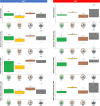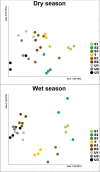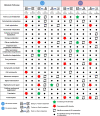Spatial distribution of sediment bacterial communities from São Francisco River headwaters is influenced by human land-use activities and seasonal climate shifts
- PMID: 37910306
- PMCID: PMC10689647
- DOI: 10.1007/s42770-023-01150-8
Spatial distribution of sediment bacterial communities from São Francisco River headwaters is influenced by human land-use activities and seasonal climate shifts
Abstract
Riverbed sediments are dynamic freshwater environments colonized by a great diversity of microorganisms which play important roles in supporting freshwater ecosystem by performing a vast array of metabolic functions. Recent evidence generated by HTS approaches has revealed that the structure of sediment microbial communities is influenced by natural seasonal variations in water such as temperature or streamflow as well by disturbances caused by local human activities. Here, a spatiotemporal analysis of sediment microbial distribution from São Francisco River headwaters section was conducted using Illumina 16S rRNA-V4 region amplicon sequencing in order to accomplish three major goals: (i) to investigate whether the diversity and composition of bacterial communities accessed in riverbed sediments vary in response to distinct land-use activities; (ii) to estimate whether the diversity patterns vary between the dry and wet seasons; and (iii) to evaluate whether the diversity of bacterial metabolic functions, predicted by PICRUSt2 approach, varies similarly to the estimated taxonomic diversity. Our findings revealed that bacterial communities in the sediment show differences in diversity and taxonomic composition according to the anthropic activities performed in the local environment. However, the patterns in which this taxonomic diversity is spatially structured show differences between the dry and wet seasons. On the other hand, the most changes in predicted bacterial metabolic functions were verified between sediment samples accessed in portions of the river located in protected and unprotected areas. Our findings contributed with new evidence about the impact of typical land-use practices conducted in countryside landscapes from developing countries on riverbed bacterial communities, both in their taxonomic and functional structure.
Keywords: 16S rDNA; Bacterial communities; Land-use; River; Sediment.
© 2023. The Author(s) under exclusive licence to Sociedade Brasileira de Microbiologia.
Conflict of interest statement
The authors declare no competing interests.
Figures








Similar articles
-
Integrated biogeography of planktonic and sedimentary bacterial communities in the Yangtze River.Microbiome. 2018 Jan 19;6(1):16. doi: 10.1186/s40168-017-0388-x. Microbiome. 2018. PMID: 29351813 Free PMC article.
-
Spatial and seasonal variations of sediment bacterial communities in a river-bay system in South China.Appl Microbiol Biotechnol. 2021 Mar;105(5):1979-1989. doi: 10.1007/s00253-021-11142-z. Epub 2021 Feb 5. Appl Microbiol Biotechnol. 2021. PMID: 33544213
-
Distinctive Patterns in the Taxonomical Resolution of Bacterioplankton in the Sediment and Pore Waters of Contrasted Freshwater Lakes.Microb Ecol. 2018 Apr;75(3):662-673. doi: 10.1007/s00248-017-1074-z. Epub 2017 Sep 17. Microb Ecol. 2018. PMID: 28920165
-
Sediments and Soils Act as Reservoirs for Taxonomic and Functional Bacterial Diversity in the Upper Mississippi River.Microb Ecol. 2016 May;71(4):814-24. doi: 10.1007/s00248-016-0729-5. Epub 2016 Feb 15. Microb Ecol. 2016. PMID: 26879939
-
Climate and land-use changes affecting river sediment and brown trout in alpine countries--a review.Environ Sci Pollut Res Int. 2009 Mar;16(2):232-42. doi: 10.1007/s11356-008-0075-3. Epub 2008 Dec 2. Environ Sci Pollut Res Int. 2009. PMID: 19048320 Review.
References
-
- Gutknecht JL, Goodman RM, Balser TC. Linking soil process and microbial ecology in freshwater wetland ecosystems. Plant Soil. 2006;289:17–34. doi: 10.1007/s11104-006-9105-4. - DOI
-
- Sigee D. Freshwater microbiology: biodiversity and dynamic interactions of microorganisms in the aquatic environment. John Wiley & Sons; 2005.
MeSH terms
Substances
LinkOut - more resources
Full Text Sources

